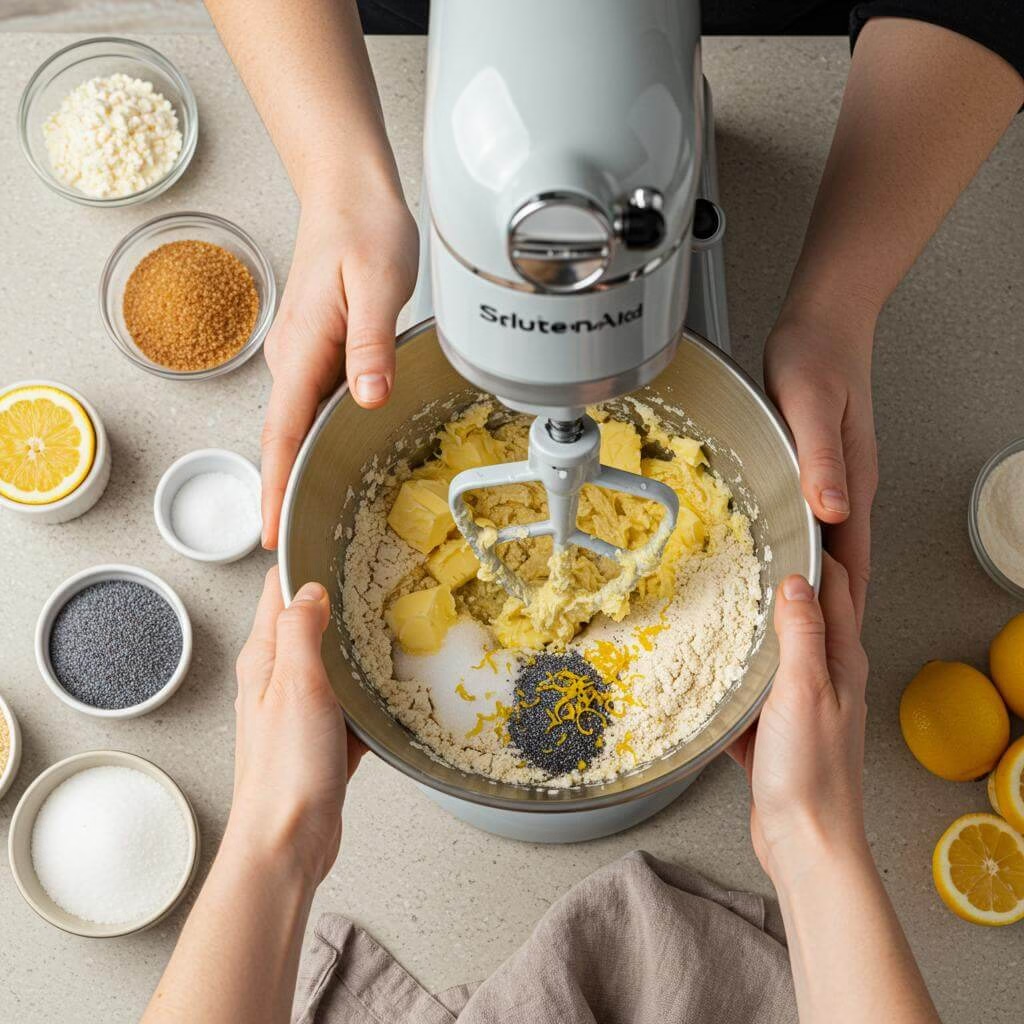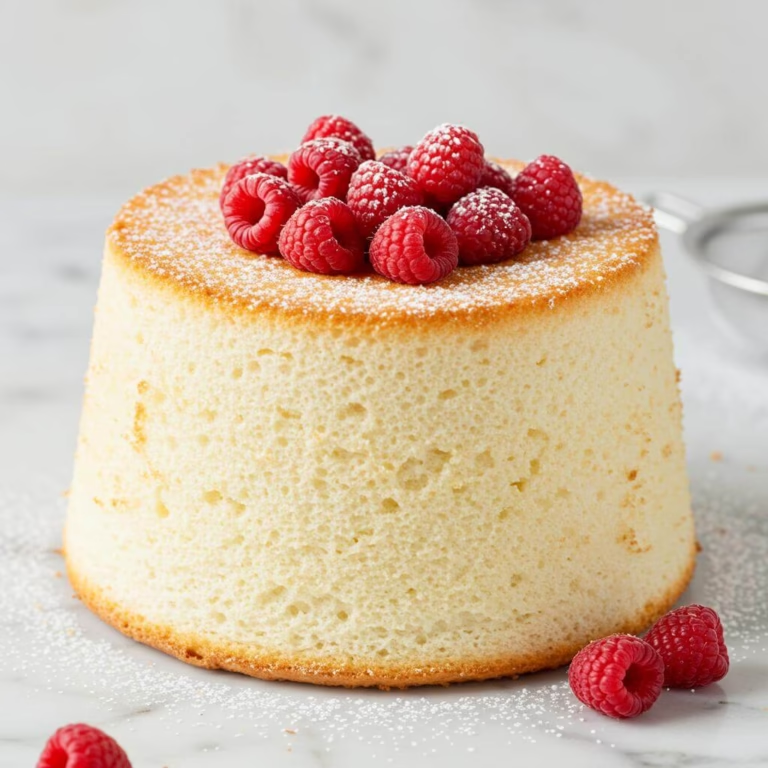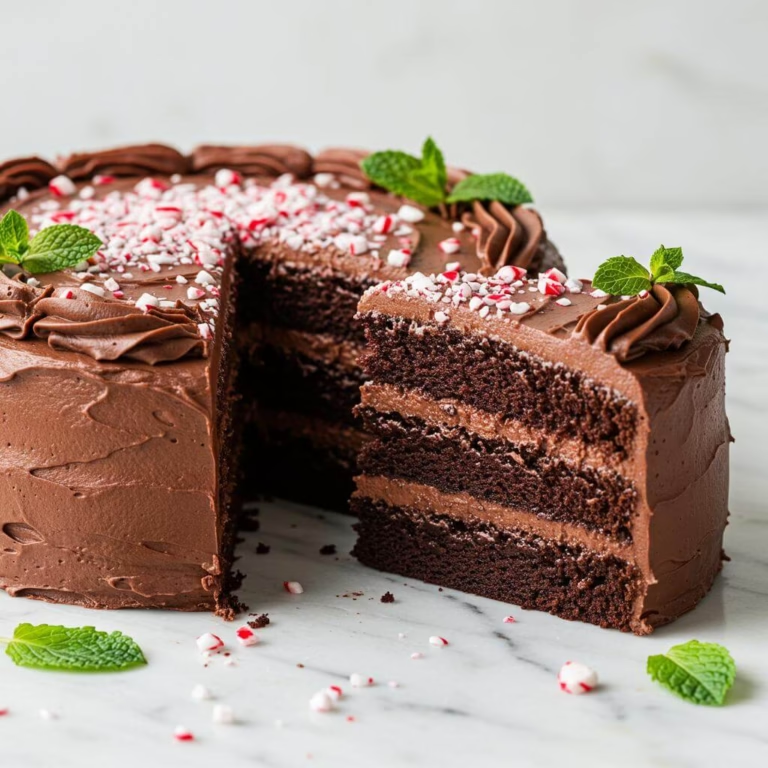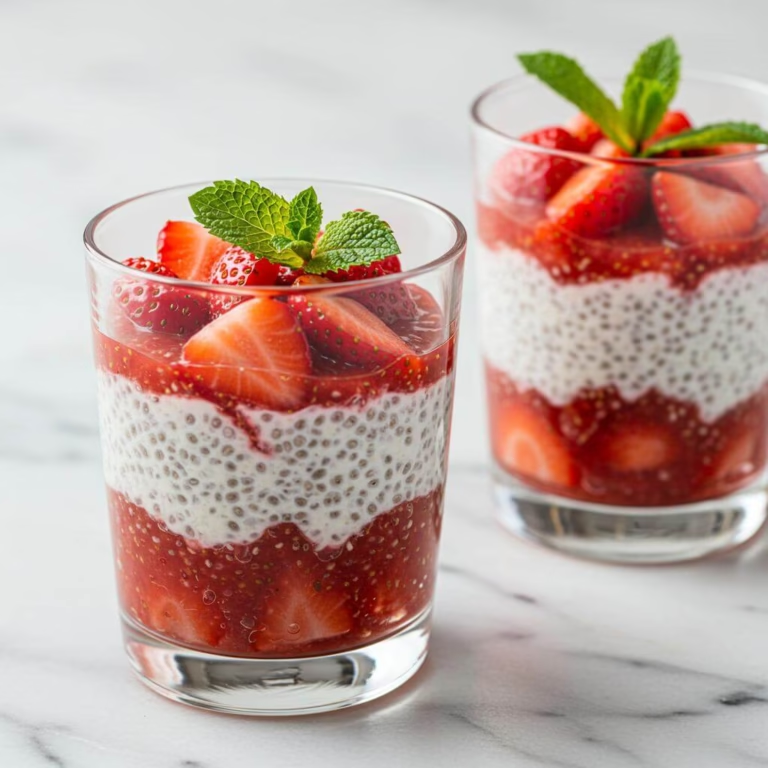Oh, gluten-free baking. It can be a journey, can’t it? We’ve all been there, holding our breath as something comes out of the oven, praying it’s not another dense, crumbly disappointment or, worse, a gummy, heavy brick. The promise of a light, tender cake flickering like a distant, unattainable dream. For the longest time, that dream felt particularly far off when it came to classics, those comforting cakes that hold so many memories. Things like a perfect gluten-free chocolate cake seemed challenging enough, but adding the bright, zesty complexity of lemon along with the subtle crunch of poppy seeds? It felt like asking for a miracle.
Specifically, perfecting a truly great lemon poppy seed cake felt like my personal Everest. I remember countless attempts that resulted in cakes that looked the part but completely missed the mark on texture. Some were too dry, falling apart if you looked at them funny. Others were disappointingly rubbery, a far cry from the tender crumb you expect from a beautiful lemon poppy seed cake. I tinkered with flour blends, played with the amount of xanthan gum, adjusted liquid ratios, and even tried different baking methods. My kitchen saw its share of gluten-free fails, let me tell you!
But here’s the thing about being a gluten-free baker: persistence pays off. Each less-than-perfect cake taught me something new – about the delicate balance required, the specific quirks of gluten-free flours, and how to coax moisture and tenderness into a batter without relying on traditional wheat. My quest wasn’t just for *any* gluten-free lemon poppy seed cake; it was for *the one* that could stand proudly alongside its gluten-containing cousins, the one that tasted like sunshine and happiness in every bite.
And friends, after much experimentation, many taste tests (volunteering friends were always a plus!), and slight tweaks to a beloved base recipe (you might recognize elements from my gluten-free lemon poppyseed muffins, which share that zesty DNA!), I finally cracked the code. This recipe isn’t just a decent gluten-free alternative; it’s an absolutely phenomenal lemon poppy seed cake that happens to be gluten-free. It’s incredibly moist, thanks to a clever technique I’ll share below, wonderfully fluffy, dotted generously with those delightful poppy seeds, and topped with a tangy lemon glaze that’s simply addictive.
Forget those past gluten-free baking frustrations. This lemon poppy seed cake is your triumph. It’s proof that you don’t have to settle for second best just because you eat gluten-free. Whether you’re craving a slice for breakfast, afternoon tea, or dessert after making something savory like chicken quinoa burrito bowls, this cake delivers pure joy. The aroma that fills your kitchen as it bakes is worth the journey alone! Prepare to fall in love with gluten-free baking all over again, because this lemon poppy seed cake is a game-changer.
Love This Lemon Poppy Seed Cake? Unlock More Baking Wins!
Making delicious gluten-free treats like this lemon poppy seed cake is a joy, but sometimes finding the right swaps can be a challenge, right? We’ve all been there!
That’s why we created a FREE Gluten-Free Baking Substitutions Cheat Sheet just for our Be Gluten Free community. Say goodbye to baking guesswork!
- ‘) no-repeat left center; background-size: 20px 20px;”>
Instantly know how to replace common ingredients like eggs, dairy, or gums. - ‘) no-repeat left center; background-size: 20px 20px;”>
Achieve the perfect texture in your gluten-free cakes, cookies, and breads every time. - ‘) no-repeat left center; background-size: 20px 20px;”>
Save time and avoid costly baking fails with our tried-and-tested swaps. - ‘) no-repeat left center; background-size: 20px 20px;”>
Expand your gluten-free baking repertoire with newfound confidence!
Join fellow gluten-free friends and make your baking journey smoother and more delicious.
Download Your FREE Cheat Sheet!
We value your privacy. No spam, just helpful gluten-free goodness, promise!
Why This Lemon Poppy Seed Cake Recipe Works
So, what makes this gluten-free lemon poppy seed cake so incredibly moist, fluffy, and utterly delicious? It’s a beautiful combination of smart ingredient choices and a clever baking technique that harnesses the unique properties of gluten-free ingredients. This isn’t just baking; it’s the fascinating chemistry that delivers perfect results every time.
The secret to this recipe’s success starts with the carefully chosen blend of flours. Using a combination of a standard plain gluten free flour blend and finely ground almond flour is brilliant. The blend provides the necessary structure that gluten would typically offer, while the almond flour contributes rich moisture, tender crumbs, and a subtle depth of flavor that perfectly complements the bright lemon.
Here’s where the gluten-free structure truly shines: the addition of xanthan gum (if your blend doesn’t contain it). This ingredient is the unsung hero, acting as a binder to mimic the elasticity and structure of gluten. It’s what prevents the cake from being crumbly, ensuring your slice of **lemon poppy seed cake** holds together beautifully while still being wonderfully tender.
But what truly elevates the texture of this **lemon poppy seed cake** is the reverse creaming method. Instead of creaming butter and sugar together initially, you work the softened butter into the dry ingredient mix first. This coats the flour and starch particles with fat. What’s remarkable about this technique is that when you add the wet ingredients (like eggs, milk, and lemon juice), this fat coating slows down the absorption of liquid. The result? A significantly finer, tighter, and velvety-soft crumb that feels incredibly light and moist – a texture that can sometimes be challenging to achieve in gluten-free baking but is perfected right here in this **lemon poppy seed cake**.
The ample amount of moisture from the butter, eggs, and milk, combined with the acidity of the fresh lemon juice, is also key. This balance ensures the cake stays incredibly moist and tender for days. The lemon juice also interacts with the baking powder, giving the cake a lovely lift and contributing to its airy texture.
Finally, the vibrant burst of flavour isn’t just from the lemon zest and the delightful pop of the poppy seeds within the cake. The tangy **lemon juice** icing provides a perfect counterpoint to the cake’s sweetness and sets into a delightful, slightly crackly crust. This balance of textures and intense lemon **flavor enhancement** makes every bite a joyful experience.
Understanding how these simple ingredients like **gluten free flour**, **almond flour**, and **xanthan gum** work together, paired with smart methods like **reverse creaming**, empowers you to create baking magic like this simple **lemon poppy seed cake**. You’re not just following a recipe; you’re mastering the science of delicious gluten-free baking!

Making This Recipe Your Own
Don’t be afraid to get creative in the kitchen! This simple lemon poppy seed cake recipe is incredibly forgiving and easily adaptable. Here are some ways you can swap ingredients or add exciting new twists to make it perfect for you.
Easy Swaps
Need to make a quick switch? No problem! These simple substitutions will help you adapt the recipe while keeping the same delicious outcome for your lemon poppy seed cake.
- Gluten-Free Flour Blend: The recipe calls for a specific blend. If your blend already contains xanthan gum, simply omit the extra 1/2 tsp called for. Most store-bought gluten-free blends work well!
- Almond Flour: No almond flour? You can substitute with an equal amount (65g) of fine tigernut flour for a nut-free option, or increase the plain gluten-free flour blend by about 1/4 cup (30g). The texture might be slightly less moist, but it will still be a wonderful cake.
- Unsalted Butter: Make this recipe dairy-free by swapping the butter 1:1 with your favorite solid dairy-free butter alternative. Ensure it’s cold and cut cubed as specified for the reverse creaming method.
- Milk: Any plant-based milk like almond, soy, oat, or coconut milk beverage works perfectly here! Use the same 1/2 cup (120mL) amount. Find a plant-based milk that suits your preference.
- Vanilla Paste: If you only have vanilla extract, use double the amount (2 tsp) instead of the 1 tsp vanilla paste. The flavor will be slightly less intense but still lovely.
- Poppy Seeds: If you can’t find poppy seeds, you can technically omit them. The cake will still be delicious, just without the signature texture and appearance. For a similar crunch (but different flavor), you *could* experiment with sesame seeds, but the classic is definitely poppy.
Creative Variations
Ready to play with flavors and techniques? These ideas will help you transform the classic lemon poppy seed cake into something new and exciting!
- Add Berries: Create a delightful blueberry lemon poppy seed cake! Gently fold 1 cup of fresh or frozen (not thawed) blueberries into the batter just before transferring it to the pan. The baking time might increase by 5-10 minutes.
- Orange Poppy Seed Cake: Swap out the lemon completely! Use the zest of 2-3 large oranges and 6 tbsp of fresh orange juice in the batter. You can also use orange juice for the icing. For an extra punch, add 1 tsp of orange extract to the batter.
- Spice It Up: Add warming spices that complement the citrus! Whisk 1 tsp of ground cardamom or 1/2 tsp of ground ginger into the dry ingredients along with the flour and baking powder for a fragrant twist on your lemon poppy seed cake.
- Make Muffins or a Loaf: Instead of a square cake, divide the batter into a muffin tin (fills about 12-15 cups, fill 2/3 full) and bake at 355°F (180°C) for 20-25 minutes, or until a toothpick comes out clean. Alternatively, bake in a standard loaf pan for 60-70 minutes. The icing is delicious on either!
- Cream Cheese Swirl: For a richer flavor, swirl in a simple cream cheese mixture. Beat 4 oz softened dairy-free cream cheese with 1/4 cup powdered sugar and 1 tsp lemon juice until smooth. Dollop spoonfuls over the batter in the pan and swirl gently with a knife before baking. This makes a truly decadent lemon poppy seed cake variation!
- Double Lemon Drizzle: For intense lemon flavor, make a simple syrup by heating 1/4 cup lemon juice and 1/4 cup sugar until the sugar dissolves. Once the cake comes out of the oven, pierce it all over with a skewer or toothpick and drizzle the warm syrup over the hot cake. Let it soak in before adding the lemon icing once the cake is completely cool.

Tips for Perfect Results
- The Foundation of a Perfect Crumb: Room Temperature Ingredients. This is non-negotiable for this **lemon poppy seed cake**! Ensure your butter is genuinely softened (not melted!), eggs are not cold from the fridge, and milk is tepid. Why? Room temperature ingredients emulsify beautifully, meaning they combine smoothly. Cold ingredients can curdle the batter, leading to a lumpy texture and a less tender, more dense cake. Plan ahead – pull ingredients out 1-2 hours beforehand.
- Unlock Flavor: Rub the Zest with the Sugar. Don’t underestimate the power of citrus oils! Before adding the butter in the reverse creaming step, add the lemon zest straight to the granulated sugar in the bowl. Use your fingers to rub the zest into the sugar for a minute or two. This simple action releases the volatile oils from the lemon peel, infusing the sugar (and subsequently the entire batter) with intense, bright lemon flavor that truly makes this **lemon poppy seed cake** sing.
- Master the Reverse Creaming Method. The recipe uses the reverse creaming method for a reason! By coating the dry ingredients (flours, sugar, powder, gum, seeds) with softened butter *before* adding the wet ingredients, you inhibit the hydration of the gluten-free flours and xantham gum initially. This technique reduces the risk of toughness (yes, even GF batters can get tough if gum is over-developed) and produces that wonderfully fine, velvety crumb described in the recipe. Mix until the texture is truly like coarse sand or fine breadcrumbs before adding any liquid.
- Xanthan Gum: Your GF Binding Buddy (Used Correctly). The recipe correctly notes that you might not need xanthan gum if your blend already contains it. Always check your flour blend’s ingredient list! If your blend *doesn’t* have it (like the Doves Farm blend mentioned), adding the indicated amount is crucial. Xanthan gum acts as the binder that gluten provides in traditional baking, preventing your **lemon poppy seed cake** from becoming crumbly. Too little = crumbly mess; too much = gummy texture. Follow the recipe’s guidance based on your specific blend.
- The Visual Cues for Perfect Doneness. While the toothpick test is essential, also pay attention to visual cues. The cake should be beautifully golden brown on top and just starting to pull away slightly from the edges of the tin. If the top is browning too quickly but the center isn’t done (toothpick comes out with wet batter), tenting loosely with aluminum foil for the remainder of the baking time is a professional baker’s trick to prevent burning while the inside finishes baking.
- Cooling is a Two-Step Process for Structure. Don’t rush cooling. The initial 10 minutes in the tin allows the cake’s structure to set gently as it cools. Removing it too early can cause it to collapse. Transferring it to a wire rack after 10 minutes is equally important – this allows air to circulate underneath, preventing the bottom from becoming soggy from trapped steam. Patience during cooling yields a superior **lemon poppy seed cake** texture.
- Achieve the Ideal Crackly Icing. The description mentions a lovely crackly icing crust. To get this, the consistency of your icing is key. Mix the powdered sugar and lemon juice slowly, adding the lemon juice a teaspoon at a time until a thick, but pourable, consistency is reached. It should drizzle but hold its shape somewhat on the surface. Drizzling it while the cake is still slightly warm (as the recipe suggests, though technically cooler is better for a perfect set) can sometimes help it spread nicely before it starts to set. Sprinkling poppy seeds when it’s *half-set* means they stick perfectly without sinking or just rolling off a wet surface.
Common Mistakes to Avoid
- Using Cold Ingredients: As mentioned in the tips, cold butter, eggs, and milk will prevent the batter from emulsifying correctly. This results in a less smooth batter and a final cake texture that is often dense or even slightly curdled rather than light and velvety. **Prevention:** Always bring ingredients to room temperature before starting.
- Over-mixing the Batter: Once the wet ingredients are added, mix *just* until everything is combined and there are no visible flour clumps. While GF batters are less prone to toughness from gluten development, over-mixing can still negatively impact the texture by overworking the xanthan gum (making it slightly gummy) or incorporating too much air which can collapse during baking. **Prevention:** Mix on low speed or by hand until just combined and smooth.
- Overbaking the Cake: This is the nemesis of any good cake, but especially gluten-free cakes which can dry out quickly. Baking too long guarantees a dry, crumbly **lemon poppy seed cake**. **Prevention:** Start checking for doneness slightly before the minimum listed time (around 45 mins). Use the visual cues *and* the toothpick test. A few moist crumbs clinging to the toothpick indicate it’s done, not a clean, dry stick!
By following these expert tips and avoiding common pitfalls, you’ll transform your simple **lemon poppy seed cake** into a baking triumph every single time. Happy baking!
Common Mistakes to Avoid
Baking gluten-free, especially a delightful treat like this lemon poppy seed cake, is incredibly rewarding, but like any baking adventure, there are a few common pitfalls. Don’t worry, we’re here to help you navigate them! Understanding why things go wrong is the first step to baking success.
Getting the Gluten-Free Flour Blend or Xanthan Gum Wrong
The Problem: Gluten-free flour blends vary significantly. Using the wrong type (like a bread blend or one with added leavening) or miscalculating the xanthan gum (adding too much or too little when your blend already contains it) can completely change the texture of your cake. Too little structure leads to a crumbly mess, too much xanthan can make it gummy or dense.
Why it Happens: In traditional baking, gluten provides structure and elasticity. Gluten-free flours lack this, and xanthan gum acts as a binder to mimic some of those properties. Different blends use different starch and flour ratios, affecting liquid absorption and structure building.
Prevention: Stick to the recommended type of flour blend (a plain or all-purpose blend is best for cakes). Check the ingredients list on your GF flour bag to see if it already contains xanthan gum. If it does, you can omit the extra 1/2 tsp called for in the recipe. Weigh your flour accurately using kitchen scales, as cup measurements can be inconsistent for GF blends.
Pro Tip: If your first attempt with a specific blend isn’t perfect, make notes! You might need to slightly adjust the liquid or xanthan gum next time based on how that particular blend behaves.
Over-Mixing the Batter After Adding Wet Ingredients
The Problem: Unlike wheat flour, gluten-free flours don’t develop gluten when mixed. However, over-mixing can still negatively impact the texture by overworking the starches and emulsifiers, leading to a tougher, denser, or even slightly gummy crumb in your lemon poppy seed cake.
Why it Happens: While you won’t develop gluten, you can still create an undesirable texture by incorporating too much air or overworking the ingredients beyond the point of just being combined. The reverse creaming method used here helps coat the flour in fat first, reducing tough texture risk, but the final mixing step is still crucial.
Prevention: Once the wet ingredients are added to the butter-flour mixture, mix *just* until everything is evenly combined and you no longer see any dry streaks or flour clumps. Stop the mixer and scrape down the sides and bottom of the bowl with a spatula to ensure everything is incorporated without excessive mixing.
Pro Tip: Mixing on a lower speed once the wet ingredients are added can also help prevent over-mixing.
Over-Baking Your Lemon Poppy Seed Cake
The Problem: Gluten-free cakes, including this lovely lemon poppy seed cake, can go from perfectly moist to dry very quickly if left in the oven too long. The edges might become hard or crumbly, and the overall texture will be less enjoyable.
Why it Happens: Without gluten to help retain moisture, GF cakes are more susceptible to drying out as heat continues to evaporate liquids during baking. The visual cues might look right, but the internal temperature might be too high.
Prevention: Start checking your cake a few minutes before the minimum bake time specified (around 45-50 minutes). Use a toothpick inserted into the center; it should come out clean or with just a few moist crumbs attached, not wet batter. Trust your oven thermometer if you have one, and use the foil trick mentioned in the recipe if the top is browning too fast before the inside is done.
Pro Tip: Every oven is different! Get to know yours. If you notice the top is browning too fast consistently, try lowering the oven temperature slightly next time or position the rack lower.
Icing the Cake While It’s Still Too Warm
The Problem: While the recipe acknowledges the temptation to ice the cake warm, applying the lemon icing before the cake has significantly cooled can cause the icing to melt and run off the sides excessively, resulting in a thin, uneven layer instead of the beautiful, slightly crackly crust described.
Why it Happens: Heat from the cake transfers to the icing, melting the powdered sugar and increasing the liquidity of the citrus juice and sugar mixture, preventing it from setting properly on top.
Prevention: The recipe suggests letting it cool for 10 minutes in the tin and then transferring to a wire rack. For the best icing results (that perfect drizzle consistency that sets into a crust), let the cake cool completely on the wire rack. It requires patience, but it’s worth it for the texture and appearance of the icing.
Pro Tip: If you accidentally iced it too warm and it’s too runny, you *can* let that layer set somewhat, then mix up a slightly thicker batch of icing (add a tiny bit more powdered sugar) and drizzle a second layer on top once the cake is fully cool.
Common Mistakes to Avoid
Baking gluten-free, especially a delightful treat like this lemon poppy seed cake, is incredibly rewarding, but like any baking adventure, there are a few common pitfalls. Don’t worry, we’re here to help you navigate them! Understanding why things go wrong is the first step to baking success.
Getting the Gluten-Free Flour Blend or Xanthan Gum Wrong
The Problem: Gluten-free flour blends vary significantly. Using the wrong type (like a bread blend or one with added leavening) or miscalculating the xanthan gum (adding too much or too little when your blend already contains it) can completely change the texture of your cake. Too little structure leads to a crumbly mess, too much xanthan can make it gummy or dense.
Why it Happens: In traditional baking, gluten provides structure and elasticity. Gluten-free flours lack this, and xanthan gum acts as a binder to mimic some of those properties. Different blends use different starch and flour ratios, affecting liquid absorption and structure building.
Prevention: Stick to the recommended type of flour blend (a plain or all-purpose blend is best for cakes). Check the ingredients list on your GF flour bag to see if it already contains xanthan gum. If it does, you can omit the extra 1/2 tsp called for in the recipe. Weigh your flour accurately using kitchen scales, as cup measurements can be inconsistent for GF blends.
Pro Tip: If your first attempt with a specific blend isn’t perfect, make notes! You might need to slightly adjust the liquid or xanthan gum next time based on how that particular blend behaves.
Over-Mixing the Batter After Adding Wet Ingredients
The Problem: Unlike wheat flour, gluten-free flours don’t develop gluten when mixed. However, over-mixing can still negatively impact the texture by overworking the starches and emulsifiers, leading to a tougher, denser, or even slightly gummy crumb in your lemon poppy seed cake.
Why it Happens: While you won’t develop gluten, you can still create an undesirable texture by incorporating too much air or overworking the ingredients beyond the point of just being combined. The reverse creaming method used here helps coat the flour in fat first, reducing tough texture risk, but the final mixing step is still crucial.
Prevention: Once the wet ingredients are added to the butter-flour mixture, mix *just* until everything is evenly combined and you no longer see any dry streaks or flour clumps. Stop the mixer and scrape down the sides and bottom of the bowl with a spatula to ensure everything is incorporated without excessive mixing.
Pro Tip: Mixing on a lower speed once the wet ingredients are added can also help prevent over-mixing.
Over-Baking Your Lemon Poppy Seed Cake
The Problem: Gluten-free cakes, including this lovely lemon poppy seed cake, can go from perfectly moist to dry very quickly if left in the oven too long. The edges might become hard or crumbly, and the overall texture will be less enjoyable.
Why it Happens: Without gluten to help retain moisture, GF cakes are more susceptible to drying out as heat continues to evaporate liquids during baking. The visual cues might look right, but the internal temperature might be too high.
Prevention: Start checking your cake a few minutes before the minimum bake time specified (around 45-50 minutes). Use a toothpick inserted into the center; it should come out clean or with just a few moist crumbs attached, not wet batter. Trust your oven thermometer if you have one, and use the foil trick mentioned in the recipe if the top is browning too fast before the inside is done.
Pro Tip: Every oven is different! Get to know yours. If you notice the top is browning too fast consistently, try lowering the oven temperature slightly next time or position the rack lower.
Icing the Cake While It’s Still Too Warm
The Problem: While the recipe acknowledges the temptation to ice the cake warm, applying the lemon icing before the cake has significantly cooled can cause the icing to melt and run off the sides excessively, resulting in a thin, uneven layer instead of the beautiful, slightly crackly crust described.
Why it Happens: Heat from the cake transfers to the icing, melting the powdered sugar and increasing the liquidity of the citrus juice and sugar mixture, preventing it from setting properly on top.
Prevention: The recipe suggests letting it cool for 10 minutes in the tin and then transferring to a wire rack. For the best icing results (that perfect drizzle consistency that sets into a crust), let the cake cool completely on the wire rack. It requires patience, but it’s worth it for the texture and appearance of the icing.
Pro Tip: If you accidentally iced it too warm and it’s too runny, you *can* let that layer set somewhat, then mix up a slightly thicker batch of icing (add a tiny bit more powdered sugar) and drizzle a second layer on top once the cake is fully cool.
Essential Equipment for This Recipe
To prepare this delicious gluten-free recipe, you’ll need the following kitchen tools:
- Mixing Bowls – A sturdy set is essential for combining wet and dry ingredients separately.
Find Mixing Bowls on Amazon - Measuring Cups and Spoons – Accuracy is key for baking!
Find Measuring Cups and Spoons on Amazon - Baking Sheets – Perfect for even baking and crisp results.
Find Baking Sheets on Amazon - Whisks – For whipping eggs and incorporating air into your batter.
Find Whisks on Amazon - Spatulas – Ideal for folding ingredients and scraping bowls.
Find Spatulas on Amazon - Food Processors – For quickly chopping and blending ingredients.
Find Food Processors on Amazon - Saucepans – Needed for melting ingredients.
Find Saucepans on Amazon - Chef’s Knives – A good knife is essential for prepping ingredients.
Find Chef’s Knives on Amazon - Cutting Boards – To protect your countertop while cutting.
Find Cutting Boards on Amazon
Frequently Asked Questions
Why does this gluten-free lemon poppy seed cake recipe use both a plain gluten-free blend AND almond flour?
That’s a great question, and it gets to the heart of successful gluten-free baking! Using a combination of flours, like a standard plain GF blend and finely ground almond flour, helps achieve the perfect texture. The plain GF blend provides structure, while the almond flour adds wonderful moisture, tenderness, and a slightly richer crumb that can sometimes be missing in GF cakes. It helps prevent that dry, crumbly texture we all want to avoid in a delicious lemon poppy seed cake!
My gluten-free flour blend already contains xanthan gum. Should I still add the 1/2 teaspoon listed in the recipe?
Nope, definitely don’t add extra if your blend already has it! The recipe specifies adding xanthan gum *if* your blend doesn’t contain it. Xanthan gum is crucial for providing structure and preventing crumbling in gluten-free baking, but too much can make your cake gummy or dense. So, check your flour blend’s ingredient list. If you see “xanthan gum” or “guar gum” listed, simply omit the extra 1/2 teaspoon from the recipe. Trust your blend’s binder!
What is the “reverse creaming” method, and why are we using it for this lemon poppy seed cake?
Ah, the secret sauce for a lovely tender cake! Traditional creaming beats butter and sugar together first. Reverse creaming, as we do here, works the softened butter into the dry ingredients *before* adding the wet ones. This process coats the flour particles with fat, which inhibits gluten development (not a concern in GF baking, but the principle applies to coating particles!) and prevents toughness. It results in a beautifully velvety, fine crumb that melts in your mouth – absolutely perfect for a moist and delightful lemon poppy seed cake!
My cake is browning too quickly on top in the oven, but isn’t done in the middle. What should I do?
This can totally happen! Different ovens and pan types might cause the top to brown faster than the inside cooks. Don’t panic! As mentioned in step 7 of the instructions, simply loosely tent the top of the baking tin with a piece of aluminum foil. This shields the top from direct heat, slowing down the browning, while allowing the inside to continue baking through. Check your cake with a toothpick again after another 10-15 minutes, keeping it tented if needed, until the toothpick comes out clean.
Can I make this simple lemon poppy seed cake dairy-free?
You absolutely can! We’ve included notes in the “Smart Substitutions” section for just this reason. You can successfully swap out the dairy milk for an equal amount of your favorite unsweetened plant-based milk (like almond, oat, or soy). For the butter, make sure to use block-style dairy-free baking sticks, ensuring they are softened to the same consistency as regular softened butter before incorporating them. With these simple swaps, you can enjoy a delicious dairy-free version!
My lemon icing is too thick/too thin. How can I fix the consistency?
Great question – getting the icing *just* right is key! The consistency described (runny enough to drizzle, but thick enough to form a layer) is ideal for that perfect tangy glaze. If your icing is too thick, add a tiny splash more lemon juice – start with just 1/2 teaspoon at a time and stir well before adding more. Lemon juice is powerful, so add slowly! If it’s too thin, gradually stir in a little more sifted powdered sugar (a tablespoon at a time) until you reach the desired drizzling consistency. It’s easier to add more liquid/powder than to take it away, so adjust slowly!
How should I store leftover lemon poppy seed cake, and can I freeze it?
This lemon poppy seed cake keeps wonderfully! Store any leftovers in an airtight container at room temperature for 3-4 days. The icing will firm up slightly, creating a lovely crackly crust. Yes, you can definitely freeze individual slices or the whole cake (without the icing is sometimes best, adding fresh icing after thawing). Wrap the cooled cake or slices tightly in plastic wrap, then again in aluminum foil or place in a freezer-safe container for up to 3 months. Thaw overnight in the refrigerator or for a few hours at room temperature before enjoying.
Gluten-Free Lemon Poppy Seed Cake

Gluten-Free Lemon Poppy Seed Cake
This isn’t just a decent gluten-free alternative; it’s an absolutely phenomenal lemon poppy seed cake that happens to be gluten-free. It’s incredibly moist, wonderfully fluffy, dotted generously with poppy seeds, and topped with a tangy lemon glaze that’s simply addictive.
Ingredients
9
- 1 2/3 cups (200g) plain gluten free flour blend
- 3/4 cup (65g) almond flour
- 1/2 tsp xanthan gum (omit if your blend contains it)
- 3 tsp baking powder
- 1 cup (200g) granulated sugar
- 1 pinch salt
- zest of 3 lemons
- 2 tbsp poppy seeds
- 2 sticks (226g) unsalted butter, softened
- 4 medium eggs, room temperature
- 1/2 cup (120mL) milk, room temperature
- 1 tsp vanilla paste (or 2 tsp vanilla extract)
- 6 tbsp lemon juice, freshly squeezed
- For lemon icing:
- 1 cup (120g) powdered/icing sugar, sifted
- ~6 tsp lemon juice, freshly squeezed
- 1 tsp poppy seeds for sprinkling (optional)
Equipment
- 8×8 inch Baking Pan
- Parchment Paper
- Large Mixing Bowl
- Whisk / Sifter
- Stand Mixer or Hand Mixer
- Medium Bowl
- Spatula
- Toothpick or Cake Tester
- Aluminum Foil (optional)
- Wire Cooling Rack
- Small Bowl (for icing)
- Microplane Zester
Instructions
Preheat your oven to 355°F (180°C). Line an 8×8 inch (20×20 cm) square baking tin with parchment paper, letting the paper hang over the sides.
In a large mixing bowl, measure out your plain gluten free flour blend (200g or 1 2/3 cups), almond flour (65g or 3/4 cup), and baking powder (3 tsp). If your specific GF flour blend doesn’t already contain it, sift in the xanthan gum (1/2 tsp). Add the granulated sugar (200g or 1 cup), a pinch of salt, the zest from 3 lemons, and the poppy seeds (2 tbsp). Give everything a good whisk or stir until combined evenly.
Add your softened unsalted butter (226g or 2 sticks) directly into the dry ingredient mix. Using either a stand mixer with the paddle attachment or a hand mixer, mix on a low speed until the mixture resembles coarse breadcrumbs or damp sand.
In a separate medium bowl, whisk together your room temperature eggs (4 medium), milk (120mL or 1/2 cup), vanilla paste (1 tsp, or 2 tsp vanilla extract), and freshly squeezed lemon juice (6 tbsp).
Pour the wet ingredient mixture into the bowl with your dry ingredients and butter mixture. Continue mixing with your stand mixer or hand mixer on a medium speed until everything is fully incorporated and smooth. Don’t overmix.
Gently scrape the batter into your prepared baking tin and spread it out evenly. Place the tin into your preheated oven. Bake for approximately , or until a toothpick or cake tester inserted into the center comes out clean.
If you notice your cake is browning too quickly on top (check after about –), loosely cover the top of the tin with aluminum foil. Continue baking until the toothpick test is clean.
Remove the cake from the oven. Let it cool in the baking tin for about –. Then, lift the cake out using the parchment paper and transfer it to a wire cooling rack to cool completely.
While the cake cools, prepare the icing. In a small bowl, whisk together the sifted powdered or icing sugar (120g or 1 cup) and about 6 teaspoons of freshly squeezed lemon juice until smooth and thick. Adjust consistency with more lemon juice or sugar if needed.
Once the cake is completely cool, pour the prepared lemon icing over the top, encouraging it to drip down the sides.
Wait until the icing is half-dry (about –), then sprinkle extra poppy seeds over the wet icing.
Let the icing finish setting completely for about . Then, slice and enjoy!
Store any leftover cake in an airtight container at room temperature for 3-4 days.
Recipe Notes
- Different Gluten-Free Flour Blend: Most plain GF flour blends should work. Weighing flour (grams) is most accurate.
- Xanthan Gum: Omit the added 1/2 tsp if your GF blend already contains it.
- Dairy-Free Milk: Substitute with unsweetened plant-based milk (almond, soy, oat) in the same quantity (1/2 cup or 120 mL).
- Dairy-Free Butter: Use block-style dairy-free baking sticks, softened.
- Vanilla Paste: If using vanilla extract, use 2 teaspoons instead of 1 teaspoon of paste.
- Add Berries: Fold 1/2 cup fresh/frozen blueberries or raspberries into the batter.
- Citrus Swap: Use lime or orange zest/juice instead of lemon.
- Nutty Crunch (Optional): Add 1/4 cup finely chopped walnuts or pecans with poppy seeds.
- Textured Icing: Beat 2 tbsp softened cream cheese into the icing ingredients.
- Storage: Store in an airtight container at room temperature for 3-4 days.
Nutrition (per serving)
My #1 Recommendation
Artisan Series 5 Quart Tilt Head Stand Mixer with Pouring Shield KSM150PS, Contour Silver
(19653 reviews)
Meet your new kitchen workhorse: the Artisan Series 5 Quart Tilt-Head Stand Mixer. Designed for high performance and versatility, this mixer tackles everything from delicate meringues to dense gluten-free bread doughs with ease. Its iconic design and robust build quality make it a staple for any serious home baker.
- Versatile 5-Quart stainless steel bowl with comfortable handle.
- Secure tilt-head design for easy access to add ingredients or change attachments.
- Includes a coated flat beater, coated dough hook, 6-wire whip, and 1-piece pouring shield.
As an Amazon Associate, I earn from qualifying purchases. This helps support the blog at no extra cost to you.







